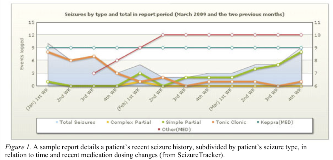Self-Management in Epilepsy: Web-Based Seizure Tracking Applications
Abstract number :
2.383
Submission category :
13. Health Services (Delivery of Care, Access to Care, Health Care Models)
Year :
2018
Submission ID :
499236
Source :
www.aesnet.org
Presentation date :
12/2/2018 4:04:48 PM
Published date :
Nov 5, 2018, 18:00 PM
Authors :
Charles M. Casassa, Beth Israel Deaconess Medical Center; Elle Rathbun, Beth Israel Deaconess Medical Center; and Daniel M. Goldenholz, Beth Israel Deaconess Medical Center
Rationale: In today’s increasingly digital world, several electronic resources are available to patients and providers for seizure tracking and epilepsy self-management. Benefits of web-based seizure diary systems include more efficient, time-stamped data entry and the ability to generate graphical summaries.1,2 Limitations include the need for some degree of digital sophistication on the part of the patient or caregiver, the cost of the underlying electronic platform, the requirement for ongoing patient/caregiver engagement, and the potential for privacy issues with data entry.1,2 While the number of available applications increases, to our knowledge there has not yet been a critical review of these options published by clinicians. Methods: We review three of the most commonly used, free web-based epilepsy self management applications: SeizureTracker, Epilepsy Foundation My Seizure Diary, and EpiDiary. We note relevant strengths and weaknesses of each of these applications, and compare and contrast various available features. Results: We found that these applications offer similar ‘core’ features, such as the ability to log seizures on mobile devices, enter detailed descriptions of seizure semiology, share information with caregivers and healthcare providers, and generate graphical summaries to examine trends over time (Figure 1). However, these tools differ significantly in terms of ease of use, supplementary features, and a number of other factors (Table 1). For example, one application does not include information about seizure-free days, which can lead the physician to make false conclusions about seizure control if not familiar with the program. Conclusions: Our findings are significant because they represent the first clinician-authored review of various electronic seizure self-management applications, which are seeing increased use by patients in today’s mobile age. As a result, clinicians should develop familiarity with some of the most commonly used resources. These tools share a similar aim, but offer various strengths and limitations, which has important implications for clinical practice.References1. Fisher RS, Blum DE, DiVentura B, et al. Seizure diaries for clinical research and practice: limitations and future prospects. Epilepsy Behav. 2012;24:304-310. 2 .Scheherazade L, Shafer PO, Bartfield E, Fisher RS. An online diary for tracking epilepsy. Epilepsy Behav. 2011;22:705-709.. Funding: None

.tmb-.png?Culture=en&sfvrsn=394432d1_0)